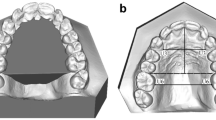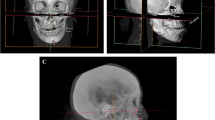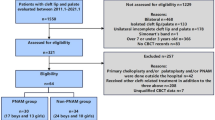Abstract
Objective
The aim of this study was to evaluate and compare the craniofacial cephalometric morphologies among different cleft types in a Spanish population.
Methods
A retrospective cross-sectional study was carried out on 212 patients. The patients were subdivided into four groups according to their cleft types: unilateral cleft lip and palate; bilateral cleft lip and palate; cleft lip; and cleft palate. Angular and linear cephalometric measurements were taken on lateral radiographs.
Results
Unilateral cleft lip and palate was associated with a dolichofacial growth pattern, skeletal Class III with correct maxillary position, and lingual incisor inclination. Bilateral cleft lip and palate was associated with a mesofacial growth pattern, skeletal Class I with protruded maxillary position, and lingual incisor inclination. Cleft palate was associated with a mesofacial growth pattern, skeletal Class III with correct maxillary position, and lingual incisor inclination. Cleft lip was associated with a brachyfacial growth pattern, skeletal Class I with protruded maxillary position, lingual upper incisor inclination, and corrects lower incisor inclination. Significant correlations were observed between cleft types and their craniofacial cephalometric measurements.
Conclusions
The present information can be used for the determination of orthodontic treatment and even future orthognathic surgery planning, a requirement in most cleft patients.




Similar content being viewed by others
References
Holst A, Holst S, Nkenke E, Fenner M, Hirschfelder U. Vertical and sagittal growth in patients with unilateral and bilateral cleft lip and palate—a retrospective cephalometric evaluation. Cleft Palate Craniofac J. 2009;46:512–20.
Toro-Ibacache V, Araya JC, Muñoz AD, Manríquez SG. Morphologic variability of nonsyndromic operated patients affected by cleft lip and palate: a geometric morphometric study. Am J Orthod Dentofac Orthop. 2014;146:346–54.
Gesch D, Kirbschus A, Mack F, Gedrange T. Comparison of craniofacial morphology in patients with unilateral cleft lip, alveolus and palate with and without secondary osteoplasty. J Craniomaxillofac Surg. 2006;34:62–6.
Goyenc YB, Gurel HG, Memili B. Craniofacial morphology in children with operated complete unilateral cleft lip and palate. J Craniofac Surg. 2008;19:1396–401.
Liao YF, Prasad NK, Chiu YT, Yun C, Chen PK. Cleft size at the time of palate repair in complete unilateral cleft lip and palate as an indicator of maxillary growth. Int J Oral Maxillofac Surg. 2010;39:956–61.
Chiu YT, Liao YF, Chen PK. Initial cleft severity and maxillary growth in patients with complete unilateral cleft lip and palate. Am J Orthod Dentofac Orthop. 2011;140:189–95.
Daskalogiannakis J, Mercado A, Russell K, Hathaway R, Dugas G, Long RE, et al. The Americleft study: an inter-center study of treatment outcomes for patients with unilateral cleft lip and palate part 3. Analysis of craniofacial form. Cleft Palate Craniofac J. 2011;48:252–8.
David DJ, Smith I, Nugent M, Richards C, Anderson PJ. From birth to maturity: a group of patients who have completed their protocol management. Part III. Bilateral cleft lip-cleft palate. Plast Reconstr Surg. 2011;128:475–84.
Liu R, Lu D, Wamalwa P, Li C, Hu H, Zou S. Craniofacial morphology characteristics of operated unilateral complete cleft lip and palate patients in mixed dentition. Oral Surg Oral Med Oral Pathol Oral Radiol Endod. 2011;112:e16–25.
Abuhijleh E, Aydemir H, Toygar-Memikoğlu U. Three-dimensional craniofacial morphology in unilateral cleft lip and palate. J Oral Sci. 2014;56:165–72.
Van den Dungen GM, Ongkosuwito EM, Aartman IH, Prahl-Andersen B. Craniofacial morphology of Dutch patients with bilateral cleft lip and palate and noncleft controls at the age of 15 years. Cleft Palate Craniofac J. 2008;45:661–6.
Hermann NV, Darvann TA, Jensen BL, Dahl E, Bolund S, Kreiborg S. Early craniofacial morphology and growth in children with bilateral complete cleft lip and palate. Cleft Palate Craniofac J. 2004;41:424–38.
Bartzela TN, Katsaros C, Bronkhorst EM, Rizell S, Halazonetis D, Kuijpers-Jagtman AM. A two-centre study on facial morphology in patients with complete bilateral cleft lip and palate at nine years of age. J Oral Maxillofac Surg. 2011;40:782–9.
Nandlal B, Utreja A, Tewari A, Chari PS. Sagittal craniofacial morphology in repaired unilateral and bilateral complete cleft lip and palate cases. J Indian Soc Pedod Prev Dent. 1996;14:45–8.
Bishara SE. Cephalometric evaluation of facial growth in operated and non-operated individuals with isolated clefts of the palate. Cleft Palate J. 1973;10:239–46.
Dahl E, Kreiborg S, Jensen BL, Fogh-Andersen P. Comparison of craniofacial morphology in infants with incomplete cleft lip and infants with isolated cleft palate. Cleft Palate J. 1982;19:258–66.
Smahel Z, Hradiský D, Müllerová Z. Multivariate comparison of craniofacial morphology in different types of facial clefts. Acta Chir Plast. 1999;41:59–65.
Ricketts RM. Foundation for cephalometric communication. Am J Orthod. 1960;46:330–57.
Tweed CH. The diagnostic facial triangle in the control of treatment objectives. Am J Orthod. 1969;55:651–67.
Jacobson A. The, “Wits” appraisal of jaw disharmony. Am J Orthod. 1975;67:125–38.
Dahl E. Craniofacial morphology in congenital clefts of the lip and palate. An x-ray cephalometric study of young adult males. Acta Odontol Scand. 1970;28(Suppl 57):11.
Ishiguro K, Krogman WM, Mazaheri M, Harding RL. A longitudinal study of morphological craniofacial patterns via P-A x-ray headfilms in cleft patients from birth to six years of age. Cleft Palate J. 1976;13:104–26.
Semb G. A study of facial growth in patients with unilateral cleft lip and palate treated by the Oslo CLP Team. Cleft Palate Craniofac J. 1991;28:22–39.
Shibasaki Y, Ross RB. Facial growth in children with isolated cleft palate. Cleft Palate J. 1969;6:290–302.
Dogan S, Oncag G, Akin Y. Craniofacial development in children with unilateral cleft lip and palate. Br J Oral Maxillofac Surg. 2006;44:28–33.
Bartzela T, Katsaros C, Rønning E, Rizell S, Semb G, Bronkhorst E, et al. A longitudinal three-center study of craniofacial morphology at 6 and 12 years of age in patients with complete bilateral cleft lip and palate. Clin Oral Investig. 2012;16:1313–24.
Acknowledgements
The authors wish to thank William James Packer for translating the manuscript into English.
Author information
Authors and Affiliations
Corresponding author
Ethics declarations
Conflict of interest
Ana López-Giménez, Javier Silvestre-Rangil, Francisco-Javier Silvestre, and Vanessa Paredes-Gallardo declare that they have no conflict of interest.
Human rights statements
All procedures followed were in accordance with the ethical standards of the responsible committee on human experimentation (institutional and national) and with the Helsinki Declaration of 1964 and later versions.
Informed consent
Informed consent was obtained from all patients for being included in the study.
Rights and permissions
About this article
Cite this article
López-Giménez, A., Silvestre-Rangil, J., Silvestre, FJ. et al. Craniofacial cephalometric morphologies in different cleft types: a retrospective cross-sectional study of 212 patients. Oral Radiol 34, 127–135 (2018). https://doi.org/10.1007/s11282-017-0290-z
Received:
Accepted:
Published:
Issue Date:
DOI: https://doi.org/10.1007/s11282-017-0290-z




